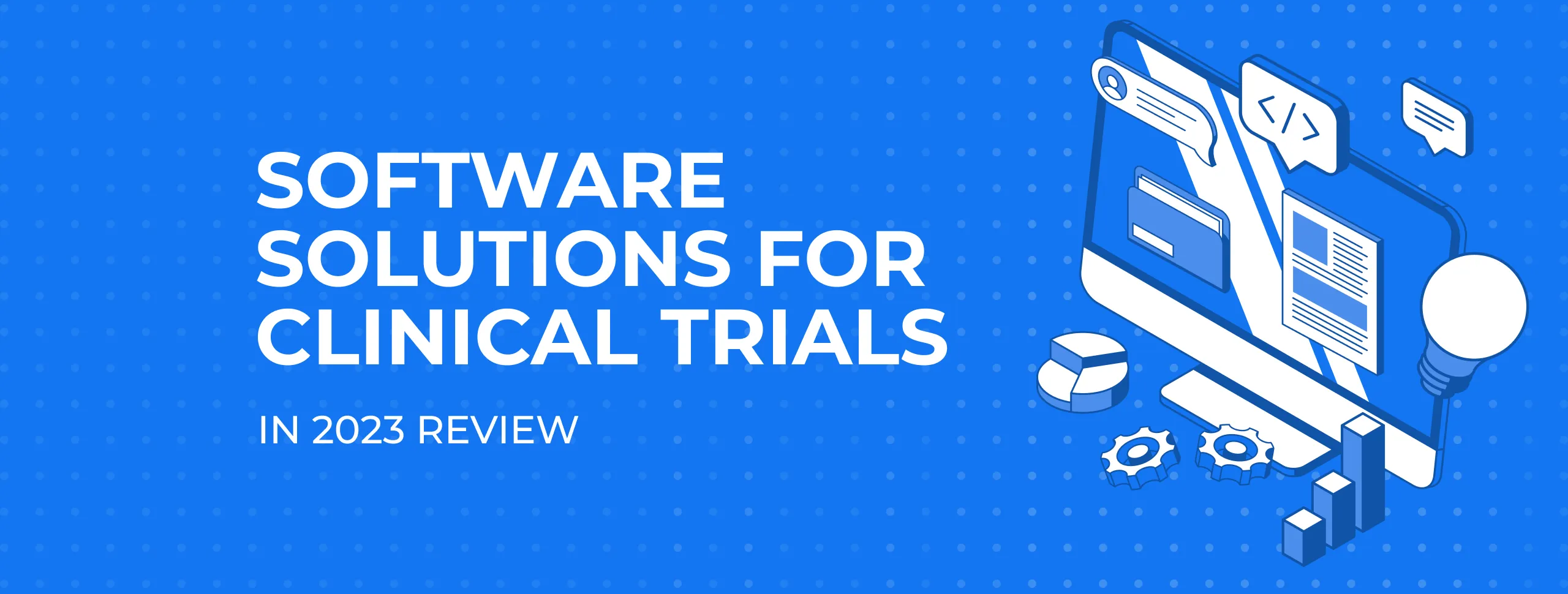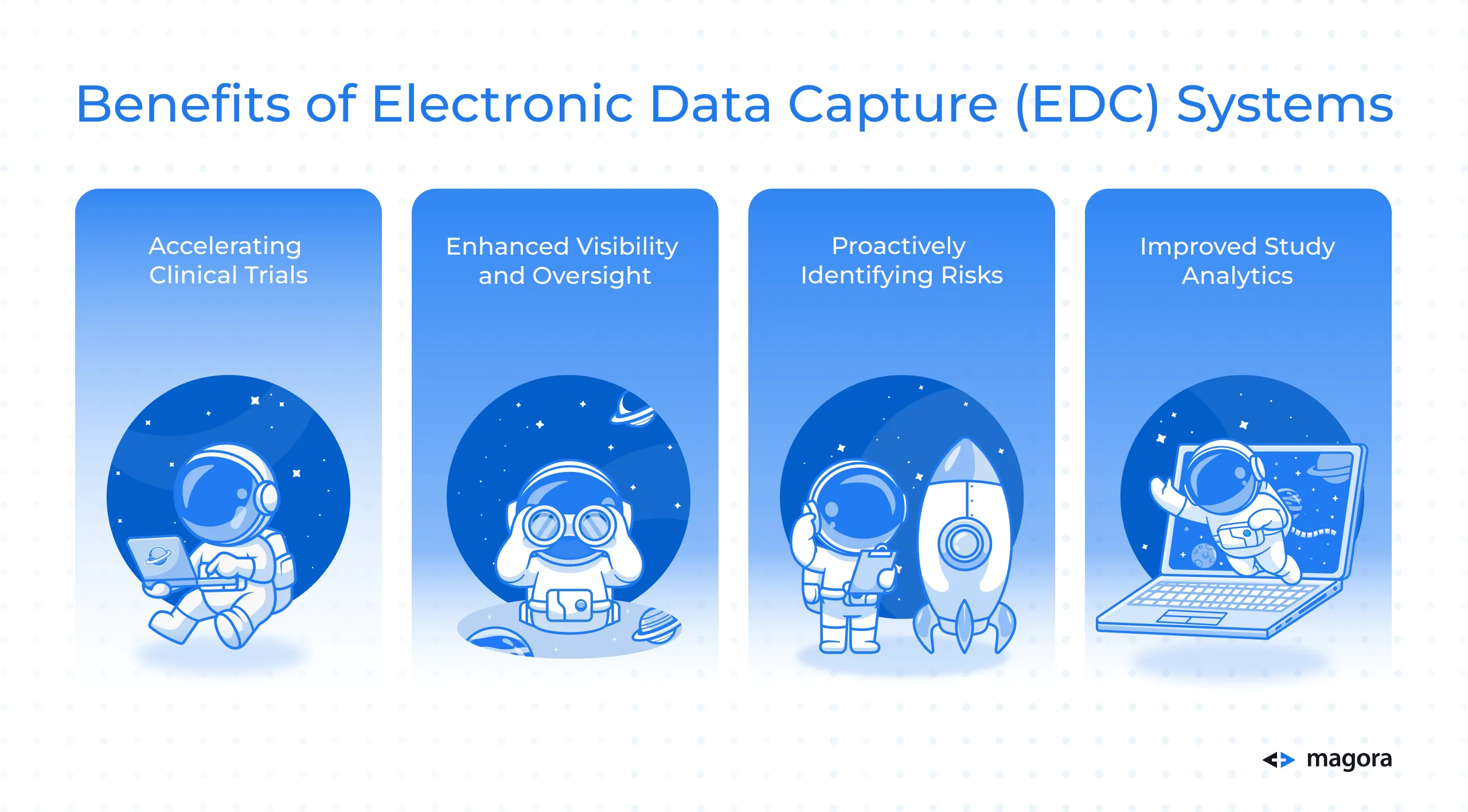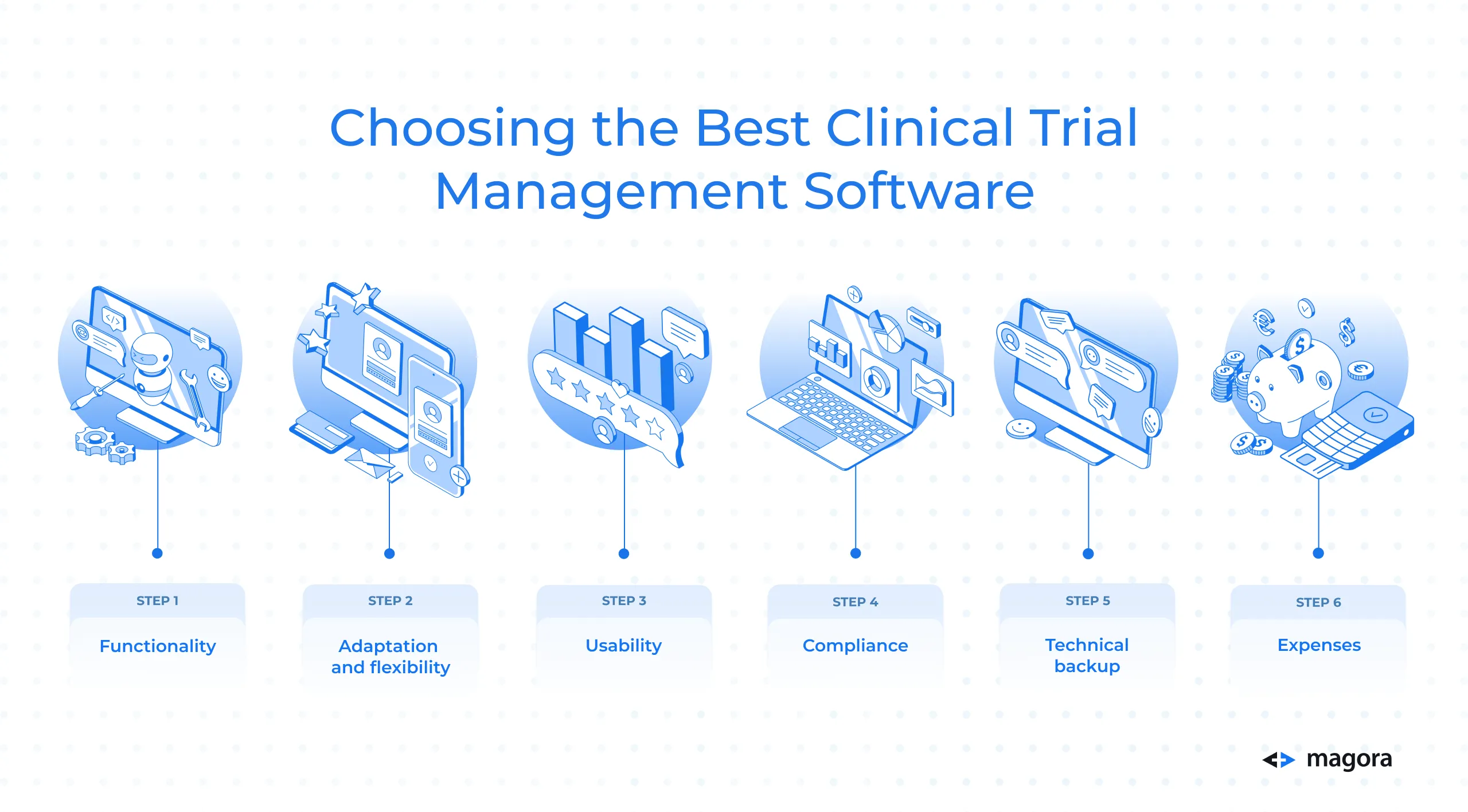
Software Solutions for Clinical Trials in 2023 Review and How to Build It From Scratch

Table of contents
- What is Clinical Trial Software?
- Clinical Research Organizations
- Clinical Trial Management Systems
- Electronic Data Capture Systems
- Clinical Metadata Repositories
- Clinical Trial Automation Software
- CRF Design
- Compliance and CTMS
- Choosing the Best Clinical Trial Management Software
- Anova solution
- Frequently asked questions
- Conclusion
Software solutions are becoming important instruments for controlling and optimizing the intricate procedures required in carrying out clinical trials in the constantly changing world of medical studies. Let's examine some software programs that have become well-known in 2023 and find out how clinical trials are carried out. The technologies themselves, which range from clinical trial management and electronic data capture systems to CRF design to, are changing the medical research landscape.
What is Clinical Trial Software?
Clinical Trial Software is a combination of different digital technologies, which aim to simplify every phase of clinical studies. They streamline procedures, guarantee legal compliance, make data collecting easier, and improve cooperation amongst parties participating in clinical research. Clinical trial software reduces the need for conventional methods that use paper by digitizing and automating procedures that require human intervention. As a result, precision, profitability and information security are all enhanced during the trial.
A standard project management software cannot handle the complexity of clinical trials. Finances, gathering data, legal compliance, research schedules, and other tasks can be managed by individual programs. Yet it is ineffective to switch between systems which do not communicate with one another well. To make sure you don't miss anything, it is preferable to maintain all of this data in one convenient location.
All of these aspects of your research work are covered by clinical trial management software. And not only these. Recent CTMS features include centralized databases, powerful data analysis and comprehensive healthcare administration tools.
Clinical Research Organizations (CROs)
Pharmaceutical companies, including industries developing biological and medical technology, significantly depend on contract research organizations, often known as clinical research organizations (CROs). Their newest drugs and equipment are tested, improved upon, and sold with the aid of CROs. With a compound annual growth rate (CAGR) of 6.5% from 2023 to 2032, Global Market Insights forecasts that the global CRO market will increase from its projected value of US$56.5 billion in 2022 to an astounding US$108 billion by 2028.
Such growth resulted from an increase of investment in research and development and from the rising amount of clinical trials requiring medical improvements. Statistics, including patent expiration, the rising availability of generic drugs on the market, as well as technical advancements affecting product development, provided a bigger picture of all factors that have contributed to a higher outsourcing of workers to CRO firms.
The past few years have witnessed exceptional employment rates in the CRO sector due to an increase in research and development (R&D). The COVID-19 pandemic prompted several clinical studies in the rush to develop a preventative vaccination as well as treatment solutions, requiring a quick and significant expansion in the number of CRO staff.
The industry has evolved significantly over the past few years as a result of mergers and acquisitions (M&A), and some of the biggest CROs have become stronger as a result of partnering with one another or being acquired by other businesses. The following represent a few of the most significant market changes:
- EQT Private Equity and Goldman Sachs Asset Management absorbed Parexel;
- Thermo Fisher Scientific purchased PPD
- IQVIA bought Clintec
- ICON acquired PRA
The CRO market is still undergoing impressive growth, including collaborative works and improvements, so 2023 promises to be quite a remarkable year bringing profitable expansion for many companies.
Clinical Trial Management Systems (CTMS)
Comprehensive software platforms known as Clinical Trial Management Systems (CTMS) are created to centralize and streamline the administrative functions of clinical trials. CTMS technologies make it easier to organize trials, set budgets, find participants, maintain research sites, handle documents, and deliver results. CTMS enables investigators to make sensible choices, improve productivity and general trial management through immediate access to development and outcome indicators.
In other words: the CTMS is a set of technologies that perform best when they all operate together like clock-work.
Electronic Data Capture (EDC) Systems
Clinical trial data collection, management and monitoring have been altered by the use of electronic data capture (EDC) technologies. Researchers may now record, verify and keep clinical trial data virtually instead of using traditional methods involving paper. EDC systems involve features including the ability to create electronic case report forms (eCRF), provide verification of information, handle queries and integrate data. In addition to increasing data quality and accuracy, digitalization also speeds up the analysis of data and lowers data entry mistakes.
The majority of clinical investigations employ both CTMS and EDC, which are complimentary products. While CTMS is concentrated on the project management parts of the clinical trial (which might include launching, paperwork, transactions, and monitoring), Electronic Data Capture (EDC) is concentrated on gathering patient data. The systems do interact, and integrating a portion of the EDC data into your CTMS is highly advantageous.
Here are some of the benefits:
1. Accelerating Clinical Trials
• Implementing a monitoring strategy to minimize the number of site visits
• Swiftly identifying low-enrolling or non-enrolling sites
• Providing user-friendly role-based dashboards and simplified navigation
2. Enhanced Visibility and Oversight
• Documenting and recognizing trends in site adherence to ICH/GCP guidelines
• Accessing accurate, real-time trial information across all study partners
3. Proactively Identifying Risks
• Monitoring subject enrollment progress and proactively addressing any delays
• Enabling a proactive closed-loop issue management system
4. Improved Study Analytics
• Managing the end-to-end trial process while gaining a comprehensive global view of tasks and milestones
• Extracting actionable insights from easily accessible self-serve reports and intuitive dashboards

Clinical Metadata Repositories
Clinical Metadata Repositories are specialized software solutions that enable standardized and consistent data representation across clinical trials. These repositories store and manage metadata, including study design elements, data dictionaries, and controlled terminology. By ensuring data standardization, clinical metadata repositories promote interoperability and facilitate data integration across multiple trials and research initiatives, ultimately enhancing data sharing, comparability, and analysis.
Clinical Trial Automation Software
Clinical metadata repositories and automated processes complete one another. You'll discover that adopting a CMDR will result in automating numerous procedures that were previously manual.
With healthcare metadata repository your company's organizational guidelines are all kept in one location. Therefore, the information is readily available and prepared for usage throughout the work process. Another significant advantage of a strong CMDR is auto-generation of research artefacts like EDC, SDTM, and ADaM requirements
Automation optimizes clinical trial procedures starting with research and up to submission. By eliminating manual procedures, investigations may be completed more quickly and with less human error factor. Additionally, documents can be rapidly tailored to the compliance requirements and data precision will be exceptional, therefore thereby making it simpler for businesses to keep up with regulatory regulations.
CRF Design
CRFs are crucial instruments for gathering patient information during clinical studies. CRF design software allows researchers to create electronic CRFs tailored to specific study protocols, capturing relevant data points efficiently. These tools offer user-friendly interfaces, drag-and-drop functionality, and form logic capabilities to streamline data collection, minimize errors, and optimize the user experience for investigators and participants.
A CRF's design has to be founded on basic scientific concepts, and it must be completed by the end-user (the individual who submits data into the CRF). Crucial CRF parts should be carefully covered while creating; it is necessary to keep in mind that incomplete or erroneous data gathering will cost more money to analyse. Hence, it is advised to establish a commonly used operational method for CRF development and to keep to useful practices of CRF designing.
Compliance and CTMS
There are a few crucial factors to take into account when it comes to CTMS and compliance:
1. An audit trail.
Any information modifications performed within the database should have a full audit trail created by the CTMS, with the details of who implemented the change, when it was done, and the old and updated contents.
2. Archival Procedure.
The CTMS is expected archive data instead of destroying it even if it is generally acceptable to delete entries from the system. This feature is more preferable because deleted information is impossible to be recovered most of the time. There are ill-intended or accidental cases of removing important data, hence archiving provides essential protection to the system.
3. Electronic signatures.
For documents that are related to your research's regulatory requirements, the CTMS must recognize electronic signatures. A great deal of the planning and tracking for the CTMS is done to ensure the smooth and successful conduct of the research, but it's possible that regulatory institutions won't be interested in it. However, online visit reports, handling of documents and eTMF have significance and should allow electronic signatures.
4. Account Protection.
The CTMS should provide controls over password expiration, idle session expiration, and lockout of unused accounts. Users should be required to be authorised and identified to the system.
Choosing the Best Clinical Trial Management Software
Without appropriate management tools, controlling your clinical trial projects may be an overwhelming process. You can quickly create reports and analytics when your complete data is in one location. This implies that because you won't be dealing with several distinct programs, your overall workflow will be more effective.
There will be no need to adapt any additional clinical trial management software because of its flexibility to expand and adapt to different projects. You will avoid installing pricey hardware by letting these programs operate on the cloud. This implies that the system and your data always stay accessible from anywhere.
In order to make a sensible decision when it comes to choosing a reliable software, it could be useful to go through the following points:
1. Functionality.
The system must be able to address any particular feature demands or study management aches and pains.
2. Adaptation and flexibility.
When it comes to field picklists, customized monitoring sectors and unique planning and tracking indicators, a reliable CTMS is expected to adapt to the procedures and regulations of your organization.
3. Usability
Your staff should be able to use the system right away.
4. Compliance
CTMS should include such options as the repository for regulated data, for example online visit reports or site relevant documents.
5. Technical backup
CTMS developing company is expected to offer assistance of a professional support team that is familiar with clinical trials and that can provide good customer service.
6. Expenses
The pricing should be transparent and start small.
7. Interoperability
Many different parties, including hospitals, research institutes, and regulatory bodies, are frequently involved in clinical studies. It can be difficult if other systems use various norms or formats for data interchange and interaction between your custom programme and others.
A standard for electronically transmitting medical information is called Fast Healthcare Interoperability Resources (FHIR). It is intended to enhance healthcare system interoperability and make it simpler to exchange and gain access to health data. FHIR has become more popular in clinical trials as well as in clinical practise.

Anova solution
The whole clinical trial method grows more complex as a result, which demands labor-intensive and drawn-out research techniques. Sponsors frequently lack access to package rules, streamlined filing processes, and approval procedures. It takes longer to match users’ profiles with relevant websites, so growth slows down due to the lack of a unified system. The strategy for enrolling participants in research projects becomes severely impacted in the end.
For Anova, we created a web platform to organise the clinical trial process and connect all participants, including physicians, research organisations, and sponsors. The technology, which functions as a one-of-a-kind central hub, automates clinical trials by enabling possible new medicines to be introduced to the market for a greater number of patients more quickly and affordably. It also accelerates the creation of new treatments through standardisation and automation.
The Anova project made a significant contribution to the efficiency, effectiveness, and organisation of clinical trial processes.
Frequently asked questions:
What is CTMS?
CTMS is a clinical trial management system developed to help sites, investors, CROs, and other suppliers manage their studies and portfolios. It may be used on a computer or a smartphone due to being web-based. Because it is a subscription-based SaaS product, we are in charge of hosting, system monitoring, and repair and maintenance.
Who is going to use CTMS?
The CTMS is management software created to assist in the administration of clinical trials. Hence, administrators of clinical trials, the nursing staff, and trial unit supervisors employed by medical centers will be the main users of this program.
Can external monitors access the platform?
Clinical Conductor, the central element of the CTMS, is responsible for organizing and managing patients as well as site management or financial matters. Independent marketers or monitors will be denied access to the platform since it does not have patient information. Monitors will assess individual health information for studies using the standard medical records system. In order to facilitate distant document tracking, clinical trial monitors will be able to connect to online registration. By receiving an invitation from the trial personnel, monitors can safely access the necessary papers for inspection.
Is private data fully secure?
According to the cyber security criteria set out by the NSW Government, the CTMS software and its data are encrypted and stored in a safe setting. Only licenced NSW Health professionals working on clinical studies are given access to the CTMS data.
How hard is it for the team to access the system?
CTMS is a software programme very similar to any online software that can be reached via a URL. The CTMS may be easily accessible on PCs, tablets, laptops, and smartphones in workplace or clinical settings since it is a web-based application. As a result, the clinical trial team will have secure and flexible access to the system.
Is using the CTMS necessary?
In order to provide correct data and benefit from all of the advantages of a CTMS, new clinical trials must be submitted as soon as the system becomes operational. Sites will get substantial training and assistance to ensure that all new clinical trials are enrolled in the CTMS during the first 12 months of implementation. This will help the adjustment to the new system go as smoothly as possible.
What types of clinical research need CTMS registration?
All clinical trials, whether they are investigator-initiated, shared, or commercial ones, are covered by the CTMS. Surveys or clinical research studies can both be entered using the CTMS.
How to build CTMS from scratch?
The building process goes through the following stages: demand study, problem analysis, designing the system, testing it through trial operations, and instructing all hospital staff on using the system.
Although creating custom CTMS software might be a difficult process, it is worthwhile if it produces a system that meets the customer's requirements. Therefore, finding the ideal technology partner with extensive knowledge in this area is crucial.
Why is it worth building clinical trial software from scratch?
There are too many nuances to consider, as every company and every case have their own peculiarities, so it stands to reason to create a fully individualised CTMS in order to provide a perfectly smooth workflow.
Conclusion
In 2023, technological innovations have become the key elements of clinical trial administration, allowing organizations and scientists to better go through the difficulties of clinical research. Such tools include a variety of programs such as metadata repositories, automation of software, clinical trial management systems and online data capture systems. They enable researchers to automate processes, improve the accuracy of data, guarantee compliance with regulations, and hasten the development of treatments that could save lives. By using these software solutions, clinical trials may be carried out more quickly, improving the patient experience and advancing medical research.
Need more information about our services?





